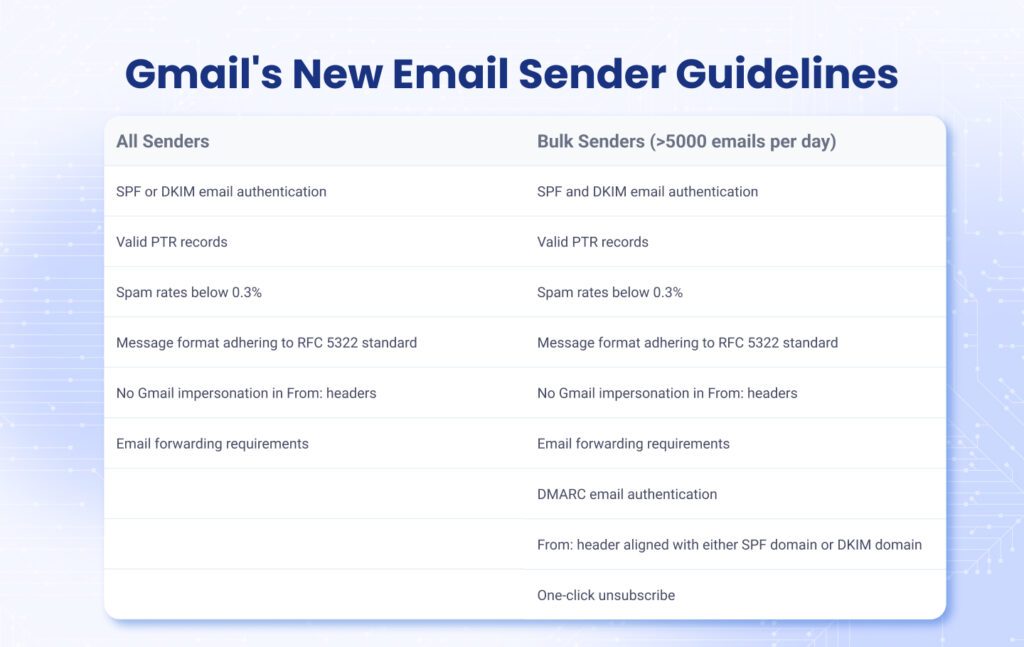Google and Yahoo new sender requirements will be coming into force on February 1, 2024. The goal? Make inboxes even safer and less cluttered with spam.
These new guidelines mainly apply to domain owners who send more than 5000 emails daily to personal accounts ending in @gmail.com, @googlemail.com, @yahoo.com, and @ymail.com. It’s worth mentioning that all emails count towards your daily email sending volume, regardless of their nature — marketing or transactional.
Both email service providers have set three main requirements to ensure email delivery: email authentication, easy unsubscribing, and a low spam rate.
Implement Email Authentication: DMARC for Google and Yahoo
All bulk senders are now required to set up SPF, DKIM, and DMARC for their sending domains.
Given the technical complexity of setting up email authentication protocols, complying with this requirement poses a certain challenge. Therefore, partnering with a third-party vendor like EasyDMARC is your guarantee for a smooth implementation and hassle-free compliance.
To pass the new Yahoo and Google DMARC requirement, you should have a valid DMARC record with a policy of at least p=none. In terms of DMARC alignment, the current guidelines only require alignment with either SPF or DKIM. However, we strongly recommend having full alignment with both SPF and DKIM since it’s likely to become a sender requirement eventually.
If you’re unsure whether your domain has any of the mentioned protocols in place, a quick scan with our Domain Scanner tool will give you all the information you need.
At the same time, setting up DMARC reports with a RUA tag is also strongly encouraged by both Google and Yahoo. This will provide you with an overview of your domain’s email traffic, information about the status of SPF, DKIM, and DMARC authentication checks, and the source that sent them.
Make Unsubscribing Easy
Email users shouldn’t have to jump through hoops to stop receiving unwanted emails. Now, marketing and subscribed messages must support a one-click unsubscribe mechanism and include a clearly visible unsubscribe link in the email body. The second link, however, doesn’t have to be one-click.
In case the user opts out of receiving emails, the sender has to comply with their request and take them off the mailing list in a maximum of two days.
Stay Under The Spam Threshold
Spam rates should be kept at or below 0.3%, that’s a rate of 3 in 1000. Ideally, it should be under 0.1%. Future messages from your domain are more likely to be reported as spam if they are frequently flagged as such. Therefore, sending emails to people who actually want to receive emails from you and avoiding unsolicited messages is your best bet.
Additional Google and Yahoo Email Requirements
Some additional requirements include:
- Ensuring that sending domains or IPs have valid PTR records.
- Formatting messages according to the Internet Message Format standard.
- Not impersonating Gmail From: headers.
- Adding ARC headers to outgoing emails if you regularly forward emails.
For more details and instructions on the new sender requirements from Google and Yahoo, you can check out Google’s Email Sender Guidelines and Yahoo’s Email Sender Requirements.
Some of these new mandates are applicable to all senders, regardless of their email-sending volume. Here’s a comparison between the guidelines for senders of less than 5000 emails per day and bulk senders.

What Happens If You Don’t Follow The Requirements
The enforcement for bulk senders that don’t meet the new Google and Yahoo email requirements will be gradual and progressive.
If your emails don’t meet the required standards by the stipulated timeline, they will likely be flagged as spam or rejected by the recipient’s email provider. This could result in a significant decrease in the number of emails reaching your audience, affecting your communication and marketing efforts.
Non-compliance may also lead to damage to your sender reputation, which is essential for determining whether your emails should be delivered to the inbox, spam folder, or rejected.
Your Google and Yahoo DMARC Journey Made Simple
Email authentication with SPF, DKIM, and DMARC is an intricate process, but it doesn’t have to be hard. With EasyDMARC, it’s easy!
Our platform simplifies DMARC implementation with a user-friendly interface, making the setup process accessible to users with various levels of technical expertise. We provide comprehensive guidance, walking you through every stage of email authentication and ensuring you have the knowledge and tools necessary for smooth compliance.



Excelent information! thanks